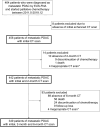Prognostic value of initial and longitudinal changes in body composition in metastatic pancreatic cancer
- PMID: 38332658
- PMCID: PMC10995276
- DOI: 10.1002/jcsm.13437
Prognostic value of initial and longitudinal changes in body composition in metastatic pancreatic cancer
Abstract
Background: Sarcopenia or visceral adipose tissue has been reported to be related to pancreatic cancer prognosis. However, clinical relevance of the comprehensive analysis of body compositions and their longitudinal changes is lacking. This study analysed the association between body composition changes after chemotherapy and survival in patients with metastatic pancreatic cancer.
Methods: We retrospectively included 456 patients (mean age ± standard deviation, 61.2 ± 10.0 years; 272 males and 184 females) with metastatic pancreatic cancer who received palliative chemotherapy from May 2011 to December 2019. Using deep learning-based, fully automated segmentation of contrast-enhanced computed tomography (CT) at the time of diagnosis, cross-sectional areas of muscle, subcutaneous adipose tissue and visceral adipose tissue were extracted from a single axial image of the portal venous phase at L3 level. Skeletal muscle index (SMI), visceral adipose tissue index (VATI), subcutaneous adipose tissue index (SATI) and mean skeletal muscle attenuation (MA) were calculated, and their effect on overall survival (OS) was analysed. Longitudinal changes in body composition and prognostic values were also analysed in a subgroup of patients with 2- and 6-month follow-up CT (n = 349).
Results: A total of 452 deaths occurred during follow-up in the entire cohort. The survival rate was 49.3% (95% confidence interval [CI], 44.9-54.2) at 1 year and 3.7% (95% CI, 2.0-6.8) at 5 years. In multivariable analysis, higher MA (≥44.4 HU in males and ≥34.8 HU in females) at initial CT was significantly associated with better OS in both males and females (adjusted hazard ratio [HR], 0.706; 95% CI, 0.538-0.925; P = 0.012 for males, and HR, 0.656; 95% CI, 0.475-0.906; P = 0.010 for females), whereas higher SATI (≥42.8 cm2/m2 in males and ≥65.8 cm2/m2 in females) was significantly associated with better OS in female patients only (adjusted HR, 0.568; 95% CI, 0.388-0.830; P = 0.003). In longitudinal analysis, SMI, VATI and SATI significantly decreased between initial and 2-month follow-up CT, whereas mean MA significantly decreased between 2- and 6-month follow-up CT. In multivariable Cox regression analysis of longitudinal changes, which was stratified by disease control state, SATI change was significantly associated with OS in male patients (adjusted HR, 0.513; 95% CI, 0.354-0.745; P < 0.001), while other body composition parameters were not.
Conclusions: In patients with metastatic pancreatic cancer, body composition mostly changed during the first 2 months after starting chemotherapy, and the prognostic factors associated with OS differed between males and females. Initial and longitudinal changes of body composition are associated with OS of metastatic pancreatic cancer.
Keywords: body composition analysis; deep learning; pancreatic cancer; survival.
© 2024 The Authors. Journal of Cachexia, Sarcopenia and Muscle published by Wiley Periodicals LLC.
Conflict of interest statement
The authors declare no conflicts of interest.
Figures



References
-
- Sung H, Ferlay J, Siegel RL, Laversanne M, Soerjomataram I, Jemal A, et al. Global cancer statistics 2020: GLOBOCAN estimates of incidence and mortality worldwide for 36 cancers in 185 countries. CA Cancer J Clin 2021;71:209–249. - PubMed
-
- Siegel RL, Miller KD, Fuchs HE, Jemal A. Cancer statistics, 2021. CA Cancer J Clin 2021;71:7–33. - PubMed
-
- Prado CM, Lieffers JR, McCargar LJ, Reiman T, Sawyer MB, Martin L, et al. Prevalence and clinical implications of sarcopenic obesity in patients with solid tumours of the respiratory and gastrointestinal tracts: a population‐based study. Lancet Oncol 2008;9:629–635. - PubMed
MeSH terms
Grants and funding
LinkOut - more resources
Full Text Sources
Medical

